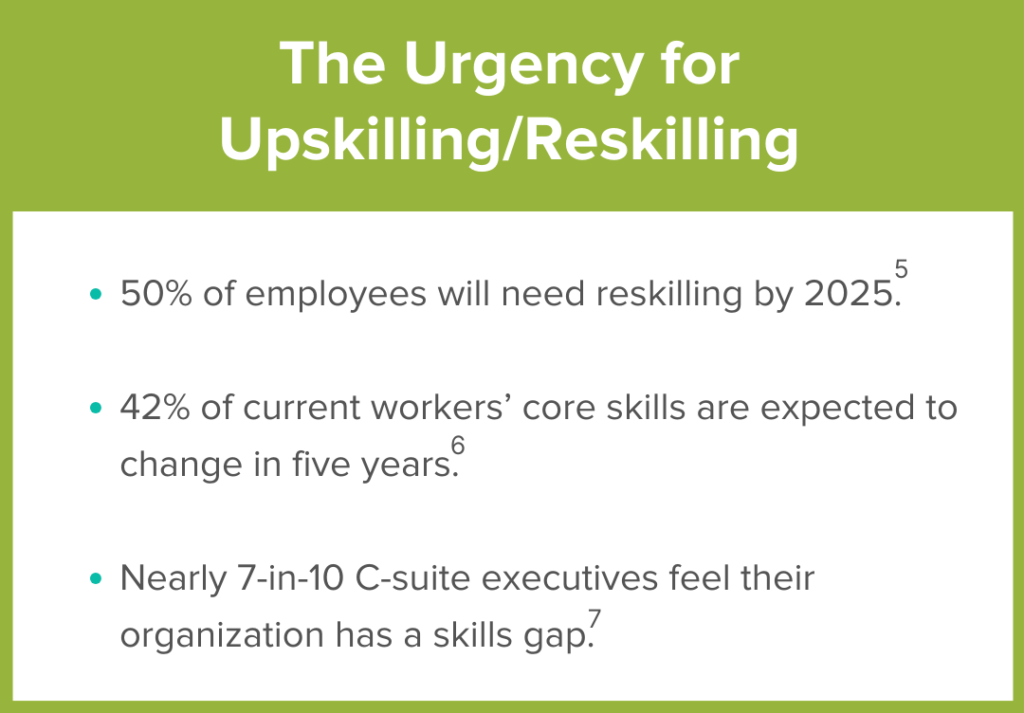As the workplace continues to undergo a profound transformation, HR professionals are tasked with creating workforces that thrive in the face of change – no simple or easy task. With 41% of HR professionals reporting understaffing in their departments1, it may seem daunting to set your sights on mastering the key HR trends emerging in 2024. That’s why we aren’t just going to recite the top priorities, we’re giving you actionable solutions to help you excel in the face of strong headwinds.
Trend #1: Leader and Manager Development.
Speaking of excelling, the top priority for HR leaders this year, according to Gartner, is leader and manager development. With 76% of HR leaders saying their managers are overwhelmed by the growth of their job responsibilities, and 73% saying their leaders and managers aren’t equipped to lead change2, it’s clear why development is a priority.
Furthering the need to focus on developing this group is the growing number of millennials taking over middle management roles. In fact, the average age of a first-time manager in the U.S. is roughly 30, an age milestone that 50% of the millennial generation has now reached. This cohort is ushering in new and different expectations of culture and a desire for continuous education and upskilling.
Today, leaders and managers need to not only be adept in traditional management practices but must be agile, empathetic, and tech-savvy, as well. Investing in their development is an investment in the adaptability and strategic competencies required to steer teams through uncertainties, foster a culture of continuous improvement, and navigate the evolving expectations of a diverse and dynamic workforce.
Assessments are one of the most effective tools to inform the development of leaders and managers. They provide an important benchmark – to understand an individual’s current skills and competencies in relation to those needed to be a successful manager or leader.
Based on science and objective data, development assessments:
- uncover blind spots or areas of weakness that were unknown to the participant, and
- identify hidden strengths, skills, or competencies that can be further leveraged or adapted.
Based on the data-based findings, a developmental action plan lays out a road map for continuous development that also allows for accountability. Research shows that when developmental action plans are based on data from assessments aligned to job role success, they are more targeted and effective.
Trend #2: Upskilling & Career Management
The critical need to upskill or reskill workers has never been more evident than in today’s landscape. As technology advances at an unprecedented pace and industries undergo rapid transformations, the skills required for success are evolving just as swiftly. Despite it gaining considerable media attention in recent years, addressing this issue still seems lacking and skill gaps appear to be shifting and growing.
And the impacts are widespread, with organizations reporting their skill gaps have:
- Hindered growth, innovation, and the ability to capitalize on opportunities (25%-29%)
- Reduced efficiency (34%)
- Decreased profitability (23%)
- Increased expenses (25%)3
Reskilling and upskilling are one component of a greater issue – the need to provide employees with clear career paths and the professional development to move them forward. Consider that 86% of HR leaders believe career paths at their organizations are unclear for many employees, and two-thirds say they are not compelling4.

With so much at stake, organizations need to find more effective ways to identify and solve skill gaps while providing more defined career paths. Unfortunately, 40% of employers don’t have upskilling or reskilling initiatives or the resources to implement them.
The good news? Talent assessments are a powerful tool to identify and address skill gaps and inform detailed and effective career development plans. And they solve what many employers believe is the root cause of their skill gaps – their inability to hire qualified employees. Using data and science-backed talent assessments help you:
- Make more informed hiring decisions by accurately identifying best-fit candidates with the necessary skills to perform the job.
- Gain reliable data on existing skill levels and potential within the organization.
- Inform skill development efforts, uncover individual skill gaps, and track progress.
- Gather data-based insights into individual role demands, expectations, and essential skills.
Trend #3: Organizational Culture.
Organizational culture is the second highest priority for HR leaders in 2024, according to Gartner8.
Further research from Gartner found that employees must be both aligned and connected to organizational culture for it to truly succeed. However, the rapid emergence of remote and hybrid work arrangements is the Achilles heal for most companies, with 76% of HR leaders saying hybrid work challenges employees’ connection to organizational culture and 61% saying that to achieve organizational goals, culture is more important in a hybrid work model than in an on-site work model9.
Contrary to popular belief, forcing employees to return to the office is not the answer to improving cultural connection and alignment. Organizations that force their employees back to a fully on-site arrangement could lose 33% of their workforce10. And it seems the level of flexibility in work arrangements directly correlates to culture connectedness – the more flexibility an employee has in where, when, and how they work, the more likely they are to be connected to their culture11.
So, let’s go back to the first measure of culture connectedness, alignment. If a hybrid work model isn’t to blame for a lack of connectedness, perhaps it is a problem with culture fit, a key aspect of creating a more meaningful experience and shared beliefs and values between employees and their employers. Cultural fit is linked to valued outcomes such as job satisfaction, organizational commitment, job performance, and retention.
Utilizing talent assessments that are designed for specific jobs, roles, and environment/culture can be more powerful in driving a better human experience and culture alignment. They are a single solution that offers an objective way to measure how well applicants’ personality styles and communication preferences fit with your culture – ultimately, creating value through the psychological bond that comes with shared values.
In addition, scientific assessment data can help identify who will work well in a virtual team or remote arrangement and who may not. Some workers need people interaction and the structure of an office environment. Others will work well independently, possess strong self-management skills, and effective collaboration capabilities, and thrive in a virtual environment. Knowing this information can help managers and HR leaders set their virtual workers up for success.
Trend #4: Employee Experience.
If the past few years have taught us anything, it’s that the only thing constant is change. In the face of rapid change, employees are more likely to adapt, perform, and remain with their employer when they feel engaged by the employee experience. Meanwhile, the latest Gallup global engagement measure shows only 32% of U.S. employees are engaged and 17% are actively disengaged.
Exceptional employee experiences result in:
- Better business outcomes and profitability – Recent research found that companies that perform well on employee experience metrics also see more revenue and profitability12.
- Greater talent attraction – Glassdoor found that applicants rate company culture higher than compensation, with 77% of applicants saying they consider company culture an important factor when considering whether to join an organization.
- Decreased turnover – Research also finds that for every 1% increase in engagement, companies see a 0.7% decrease in turnover13.
The employee experience encompasses the entire talent lifecycle, from onboarding, performance reviews, and career growth to inclusion, team and coworker dynamics, and more.
One of the most effective ways to ensure engagement and satisfaction across all aspects of the employee experience is to leverage a talent assessment and development solution that can be used across the employment lifecycle.
This impactful solution can drive better experiences, engagement, and outcomes, including:
- Better hiring decisions – predict a candidate’s ability to succeed in a specific job, industry, and culture and ensure hires are successful, motivated, and the right fit for your environment.
- Effective onboarding – Making the right hire is just the first step. Now you need to give them the resources, support, and training to thrive. Targeted assessments provide a more personalized onboarding program and shorten the time to full productivity while boosting engagement.
- Tailored career development – assessments provide insights into the strengths and preferences of employees, enabling organizations to tailor professional development plans and even day-to-day responsibilities. This leads to a more satisfying and fulfilling experience for employees.
- Team effectiveness – Analyzing team dynamics through assessments can reveal potential strengths and weaknesses in teamwork, allowing for targeted interventions and team-building exercises to improve team effectiveness and minimize conflict.
- A more inclusive culture – Understanding individual personality styles and communication preferences through assessments can foster a more inclusive work environment where everyone feels valued and heard.
Trend #5: Diversity, Equity, Inclusion, and Belonging.
Speaking of building a more inclusive culture, Diversity, Equity, Inclusion, and Belonging (DEIB) initiatives will be at the forefront of HR priorities in 2024. HR leaders will be tasked with implementing strategic DEIB strategies to drive inclusive leadership practices, enhance diversity in recruitment, and foster inclusive workplaces that value and respect all employees.
Embracing DEIB not only aligns with societal expectations, but also boosts innovation, employee engagement, and business success. Yet despite our diligence in trying to attract a more diverse applicant pool, applications, resumes, and interviews alone can be unreliable and inject bias into the hiring process. By focusing largely on experience and education through tools like resumes and unstructured interviews, companies unintentionally:
- Shrink their available talent pool.
- Hire for pedigree instead of verifiable skills.
- Impair their diversity and inclusion efforts.
Talent assessments remove unconscious hiring biases, promoting fairer and more inclusive talent selection. By using objective, science-backed data, companies gain insights into each candidate’s true potential and surface qualified candidates that may have been overlooked. Assessments focus on skills, potential, and cultural fit, creating a level playing field that promotes diversity and ensures every individual, regardless of background, has a fair chance to shine.
Conquer 2024’s Top HR Priorities.
In the ever-evolving landscape of today’s workplace, organizations like yours are faced with the perpetual challenge of attracting and retaining top talent, enhancing employee experience, bridging skill gaps, and fostering diversity and inclusion.
Sophisticated talent assessments, like XBInsight, can be a transformative game-changer, offering a proven approach to address these multifaceted challenges. Use this tool as part of your HR technology stack to build a high-performing workforce that not only meets the needs of today but anticipates the challenges of tomorrow.
Author of this article, Kathi Graham-Leviss has been a published author, speaker and founder CEO of XBInsight. For over 20 years, XBInsight has revolutionized and evolved the talent assessment market. For more on XBInsight and how it might fit into your priorities, click here. Or to sign up for more from Kathi, click here.
1 Lattice Survey, State of People Strategy Report, 2021
2 Where HR will focus in 2024. (n.d.). Gartner. https://www.gartner.com/en/articles/where-hr-will-focus-in-2024
3 Capranos, D., Magda, A. J. (2023). Closing the skills gap 2023: Employer perspectives on educating the post pandemic workforce. Maitland, FL: Wiley Inc.
4 Where HR will focus in 2024. (n.d.). Gartner. https://www.gartner.com/en/articles/where-hr-will-focus-in-2024
5 These are the top 10 job skills of tomorrow – and how long it takes to learn them. (2023, May 1). World Economic Forum. https://www.weforum.org/agenda/2020/10/top-10-work-skills-of-tomorrow-how-long-it-takes-to-learn-them/
6 Ibid.
7 Ibid.
8 Where HR will focus in 2024. (n.d.). Gartner. https://www.gartner.com/en/articles/where-hr-will-focus-in-2024
9 Gartner says HR leaders are struggling to adapt current organizational. (2022, May 17). Gartner. https://www.gartner.com/en/newsroom/press-releases/2022-05-17-gartner-says-hr-leaders-are-struggling-to-adapt-current-organizational-culture-to-support-a-hybrid-workforce
10 Ibid.
11 Ibid.
12 Luc, K. (2024, January 3). Why an employee experience solution is a must in 2024 | Culture Amp. Culture Amp. https://www.cultureamp.com/blog/why-employee-experience-solution#:~:text=Recent%20research%20found%20that%20companies,Greater%20talent%20attraction.
13 Gautier, K. (2022, March 22). Research: How employee experience Impacts your Bottom line. Harvard Business Review. https://hbr.org/2022/03/research-how-employee-experience-impacts-your-bottom-line

